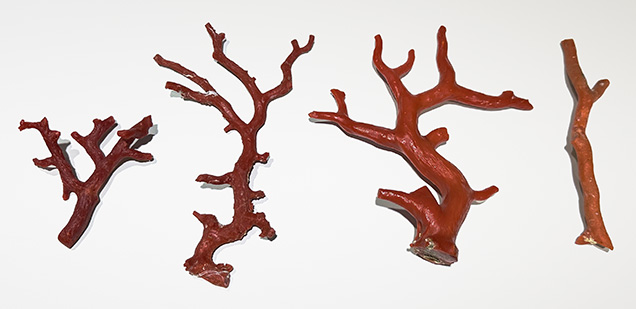Italian Precious Coral

Coral from the Mediterranean Sea has been harvested and used for adornments for thousands of years. More than 7,000 species are categorized as precious, common, or reef coral. Precious coral is defined by the World Jewellery Confederation (CIBJO) Coral Commission as “those that are used in jewelry and decoration, specifically red, pink, and white varieties with porcelain-like luster after polishing.” Italian coral harvested from the Corallium rubrum species is considered precious.
At the GJX show, the authors spoke with Sergio Di Gennaro of Fulvio Di Gennaro Srl. (Torre del Greco, Naples) about the Italian coral market. The Mediterranean has been precious coral’s major source since it was first collected for ornamentation over 3,000 years ago, followed by Taiwan and Japan with smaller quantities. Beginning in the late 1970s, Mediterranean coral was threatened by overharvesting. Di Gennaro explained that many strict regulations for harvesting coral are in place today. Harvesting is limited to coral with trunks having a basal diameter of at least 7 mm recovered from 50 meters or deeper by licensed scuba divers.
Precious coral is the exoskeleton of very tiny marine invertebrates, known as coral polyps. When a colony of polyps arrives in a particular area, they start to create the exoskeletons on rocks, growing upward in a branch-like or fan formation. Di Gennaro mentioned that divers do not harvest coral with active colonies as these will continue to grow and the future, larger coral will be more valuable. Divers therefore tend to harvest the coral where the colony has already left. Unlike other types of corals, such as common and reef, these Mediterranean “deep sea” precious corals are not a natural habitat for other marine species. Reef coral species, which are a natural environment to many different marine species, are in many cases endangered and must be preserved.
Di Gennaro explained that the quality of the coral depends on the locality. He showed us a piece of dark red coral (see above, left), which is the typical color of coral harvested from northern Sardinia. It is a darker red due to cooler water temperatures from strong currents in the area. Coral from the southern portion of Sardinia (see above, center) tends to be lighter in color. Di Gennaro described this as a more “classic” color of Mediterranean coral. He also showed us a piece of reddish orange coral called “Sciacca,” named for a town in southern Sicily where the coral is harvested (see above, right). Di Gennaro said that volcanic activity below the surface results in warmer water temperatures, which in turn causes a more orangy color.
Di Gennaro emphasized the importance of sustainability in the coral industry, noting the heritage of the city of Torre del Greco, which was built on the art of processing coral. While current restrictions have reduced the amount of coral being harvested compared to decades past, sustainable production will guarantee that we continue to see stunning Mediterranean precious coral for decades to come.



